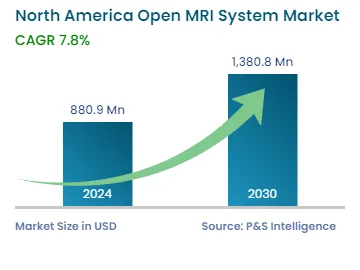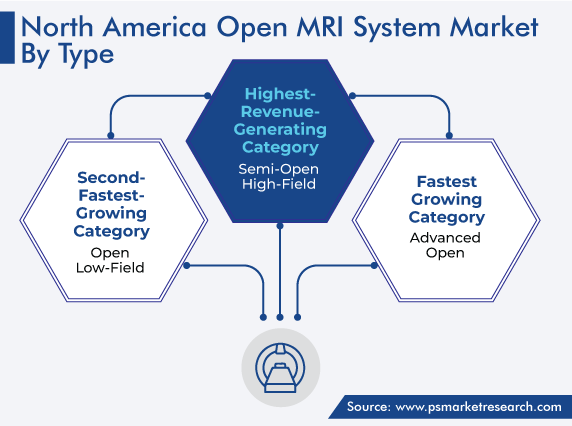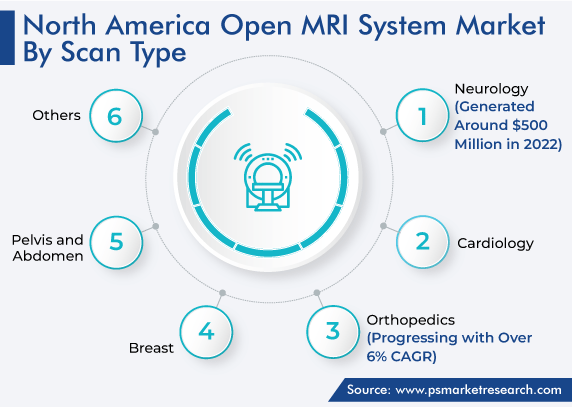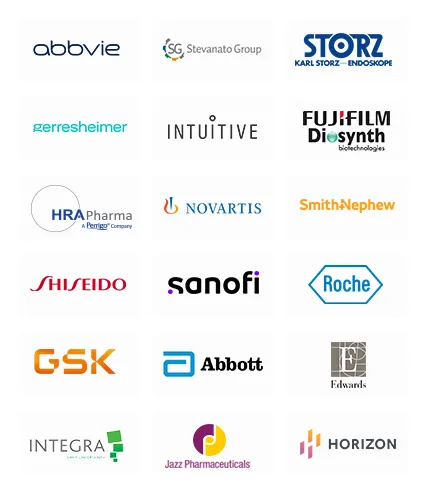Market Statistics
| Study Period | 2019 - 2030 |
| 2024 Market Size | USD 880.9 Million |
| 2030 Forecast | USD 1380.8 Million |
| Growth Rate(CAGR) | 7.8% |
| Largest Region | U.S. |
| Fastest Growing Region | Canada |
| Nature of the Market | Consolidated |
Report Code: 12654
Get a Comprehensive Overview of the North America Open MRI System Market Report Prepared by P&S Intelligence, Segmented by Type (Semi-Open High-Field, Open Low-Field, Advanced Open), Scan Type (Cardiology, Orthopedics, Breast, Neurology, Pelvis and Abdomen), End User (Hospitals and Clinics, Diagnostic Imaging Centers), and Geographic Regions. This Report Provides Insights From 2019 to 2030.
| Study Period | 2019 - 2030 |
| 2024 Market Size | USD 880.9 Million |
| 2030 Forecast | USD 1380.8 Million |
| Growth Rate(CAGR) | 7.8% |
| Largest Region | U.S. |
| Fastest Growing Region | Canada |
| Nature of the Market | Consolidated |

Explore the market potential with our data-driven report
The North American open MRI system market was valued at USD 880.9 million in 2024, and the market size is predicted to reach USD 1,380.8 million by 2030, advancing at a CAGR of 7.8% during 2024–2030. The market is driven by the increasing prevalence of chronic and acute diseases, rising geriatric population, and cost-effectiveness of open MRI systems.
The continuous R&D has enabled the creation of enhanced MRI systems in the recent past that have an improved image quality, throughput, and exam time. Some of the key advancements in this field are MRI-compatible devices and hybrid MRIs. With the advent of MRI-compatible devices, people with implanted devices can undergo MRI screening for a range of diseases. Furthermore, the development of the intraoperative MRI technology has revolutionized neurology, by playing a vital role in the diagnosis and treatment of central nervous system disorders.
Moreover, the increasing awareness on the warning signs of cancer among physicians, nurses, and other healthcare providers as well as the general public can greatly help in ensuring proper disease management. The detection of breast cancer at an early stage can help improve the survival rate, lower morbidity, and reduce the cost of care.
Semi-open, high-field variants held the largest share, of more than 45%, in 2022. These systems typically scan patients faster than other variants. In addition, these scanners can achieve greater resolutions and thinner slices, for viewing smaller parts of the anatomy. With this, the image quality becomes rather high, scan times shorten, and doctors get the ability to evaluate certain structures in the body others may not be able to.
Moreover, the advanced open MRI category is expected to grow the fastest during the forecast period, as this type is ideal for weight-bearing imaging. This new technology allows every part of the body to be imaged in the weight-bearing state, to capture the full effect of gravity on the body. This is particularly useful for patients suffering from auto or sports injuries, as advanced open MRI systems allow the patient to be positioned where they are experiencing the most pain.

The neurology category held the largest share, of around 56%, in 2022. MRI systems are extensively used for scanning the brain, head, and neck, owing to the increasing number of brain injuries in the region. In the U.S., the leading causes of traumatic brain injuries are falls (28%), motor vehicle collisions (20%), and assault (11%).

Over the years, people have become increasingly aware of the importance of preventive healthcare and early disease diagnoses. According to the Centers for Disease Control and Prevention (CDC), 33.4% of the visits to health centers in the U.S. in 2020 were for preventive care. This is because an early diagnosis of severe conditions allows patients and their families to receive timely advice and support. Moreover, the early-stage diagnosis of a diseases aids in lowering the chances of developing severe ailments in the future. This is particularly helpful in the case of cancer, with initiatives being launched in the region to spread awareness of the importance of its early diagnosis and screening.
For instance, the month of October has been dedicated to breast cancer, beginning in 1985 as a partnership between the American Cancer Society and the pharmaceutical division of Imperial Chemical Industries, to raise awareness of the screening and prevention of breast cancer. Each year, the campaign is carried out to remind people that breast cancer detection at an early stage can save lives. Moreover, the pink ribbon represents this disease around the world. Ultimately, proper disease management is ensured by the growing awareness of the early warning signs of cancer among doctors, nurses, and other healthcare providers, along with the general public.
Likewise, several neurological ailments, if detected early, can be prevented from worsening. For instance, Alzheimer’s is a neurodegenerative disorder that can be lethal if not detected and managed on time. Lately, the advances in neuroimaging have provided adequate opportunities for the study of neurological conditions, including Alzheimer’s disease. Considering the serious repercussions of such diseases, several initiatives are being taken to spread awareness of their early detection.
Drive strategic growth with comprehensive market analysis
The U.S. held the larger share, of more than 90%, in 2022. This is mainly because of the increasing prevalence of chronic diseases, rising geriatric population, and the availability of technologically advanced MRI systems in the country.
This can also be ascribed to the presence of advanced healthcare facilities, high healthcare spending, and a rise in demand for MRI scans in the U.S. Approximately 40 million MRI procedures are performed annually in the country. Moreover, the growing geriatric population in the U.S. is supporting the demand for open MRI systems for disease diagnosis, staging, and treatment monitoring. In addition, the efforts to create minimally invasive MRI systems, the advent of artifact stabilization software, the integration of AI to reduce radiologists’ workload, increase in the use of integrated PET/MRI systems for the accurate soft tissue anomaly detection, and rise in the cases of cancer and cardiac disease are boosting the market growth.
Claustrophobia is the fear of enclosed spaces. About 12.5% of the population has this fear, with the majority being females. Thus, the demand for open MRI is increasing due to the surging number of claustrophobic patients.
Furthermore, the growth of the U.S. market is owed to an increase in the demand for medical imaging services at hospitals and clinics, high patient awareness, and a favorable reimbursement scenario. The country has more than 9,841 diagnostic imaging centers in 2023, and the growing prevalence of cancer is expected to massively raise the demand for medical imaging devices in the US. For instance, in 2021, there were 1.9 million new cancer cases and 608,570 related deaths in the country.
A large number of healthcare networks in the country are focusing on early disease diagnosis. For instance, RadNet Inc. has 357 imaging centers across the U.S., where it conducts over 9 million outpatient imaging procedures each year. In addition, eRAD, its IT division, provides integrated, web- and cloud-based medical imaging workflow solutions.
Similarly, Akumin Inc. provides a comprehensive range of outpatient oncology and radiology services to physician groups, hospitals, health systems, and patients around the country. Its offerings include diagnostic imaging, advanced radiation therapy, and personalized care plans that aim to cater to the specific needs of each patient. By collaborating with an array of healthcare providers, the company offers effective and accessible critical services for improved patient outcomes.
This fully customizable report gives a detailed analysis of the North America open MRI system industry from 2019 to 2030, based on all the relevant segments and geographies.
Based on Type
Based on Scan Type
Based on End User
Regional Analysis
The open MRI system market in North America will reach USD 1,380.8 million by 2030.
The semi-open, high-field type is preferred in the North America open MRI system industry.
The open MRI system market in North America is driven by the rising incidence of neurological diseases and cancer and the increasing need for patient compliance.
The U.S. leads the open MRI system market in North America because of its larger number of imaging centers and hospitals and higher disease burden.
Want a report tailored exactly to your business need?
Request CustomizationLeading companies across industries trust us to deliver data-driven insights and innovative solutions for their most critical decisions. From data-driven strategies to actionable insights, we empower the decision-makers who shape industries and define the future. From Fortune 500 companies to innovative startups, we are proud to partner with organisations that drive progress in their industries.


Working with P&S Intelligence and their team was an absolute pleasure – their awareness of timelines and commitment to value greatly contributed to our project's success. Eagerly anticipating future collaborations.
McKinsey & Company
IndiaOur insights into the minutest levels of the markets, including the latest trends and competitive landscape, give you all the answers you need to take your business to new heights
We take a cautious approach to protecting your personal and confidential information. Trust is the strongest bond that connects us and our clients, and trust we build by complying with all international and domestic data protection and privacy laws
Customize the Report to Align with Your Business Objectives
Request the Free Sample Pages